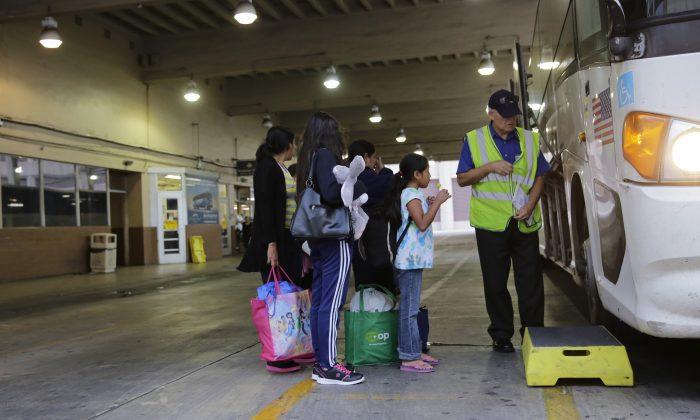SAN ANTONIO—Lawyers representing immigrant mothers held in a South Texas detention center say the women have been denied counsel and coerced into accepting ankle-monitoring bracelets as a condition of release, even after judges made clear that paying their bonds would suffice.
In a Monday letter to Sarah Saldaña, director of U.S. Immigration and Customs Enforcement (ICE), the leaders of a volunteer lawyers’ project said they were “dismayed by the lack of transparency, and the coercion, disorganization, and confusion” surrounding recent releases. Among the irregularities cited were summons to courtrooms scrawled on yellow sticky notes, no counsel or judge present in court, and women being told that the prior word of immigration judges “has no value.”
Between 70 and 100 women were called into courtrooms at the 50-acre Dilley campus last week and told by ICE officials that they could be released with ankle monitors in lieu of bonds, according to a motion filed by R. Andrew Free, a Nashville, Tennessee, lawyer working with the CARA Family Detention Pro Bono Project.
ICE appears to want ankle monitors, which use global positioning technology, on the majority of women released, Free said in an interview. The agency’s actions “are misleading people about their rights,” he said.
An immigration attorney in Denver, Laura Lichter, said that in her 20 years of practice she has never seen ICE add a monitoring device or impose other conditions after an immigration judge has set bond. She said the bracelet monitors were cumbersome, conspicuous, and required constant charging and were another tacit attempt at deterrence.
“There is a stigma,” Lichter said. “Everyone is going to think that they are criminals.”
Free said his client was among those called into a courtroom to sign the agreement, though a judge had recently reduced her bond from $7,000 to $1,500, which she'd planned on paying. A deportation officer said that even after her bond was paid, an ankle-monitoring device would also be placed on her, according to the motion. She asked to speak to her lawyer but was denied. Two similar situations were cited in affidavits, and Free added that he has heard of at least a dozen similar cases.
Free said he did not oppose women having the choice of a bracelet or bond but that “we want that choice free of coercion and duress.” Pushing the monitors is an abuse of authority, he said, that “threatens the entire immigration court process.”
After tens of thousands of migrant mothers and their children, mostly from Central America, crossed the Rio Grande last summer, the administration opened two large detention centers: a 500-bed facility in Karnes City and the enormous 2,400-bed facility in Dilley, both south of San Antonio.
In recent weeks, in the face of mounting political pressure and a federal lawsuit challenging the detention of children, ICE began moving families through the centers faster, allowing many women to receive ankle monitors instead of paying bonds. Last Friday, July 24, a federal judge in California ruled that detaining children in these centers did violate the terms of a 1997 settlement, and that families needed to be released rapidly.
The letter, signed by the American Immigration Lawyers Association and other immigrant rights groups, also says that the women are not receiving adequate information from ICE officers about their obligations in the immigration system and that the agency has not responded to the groups’ request to have lawyers do prerelease orientations. The groups said this “sets up the women for failure.” The lawyers say that similar tactics are happening in the facility in Karnes City. Until recently both Dilley and Karnes held about 2,000 people combined.
Last fall ICE privately acknowledged to a group of immigrant advocate organizations that about 70 percent of immigrant families released in the United States never showed up weeks later for follow-up appointments.





